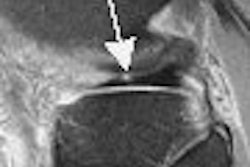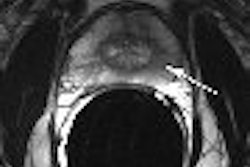(Radiology Review) Whether a coexisting adrenal mass is an adenoma or metastasis affects treatment of extra-adrenal primary tumors, according to researchers from Uludag University Medical Faculty in Bursa, Turkey. Radiologist Dr. Gursel Savci and colleagues report that while the majority of adrenal masses detected are asymptomatic adenomas, approximately half are adrenal adenomas in patients with a known history of extra-adrenal primary malignancy, and the remainder are metastases.
To improve the differentiation of adrenal adenomas from nonadenomas, 35 patients with 42 adrenal masses (eight metastases and 34 nonfunctioning adenomas) underwent "chemical shift MRI using a double-echo fast low-angle shot sequence," the authors explained. Opposed-phase chemical shift MR images were then subtracted from in-phase images (American Journal of Roentgenology, January 2006, Vol. 186:1, pp. 130-135).
For qualitative assessment, two radiologists independently reported their confidence in differentiating adenomas from nonadenomas using the signal intensity of the adrenal masses on subtraction images. For quantitative assessment, the signal intensity values of the adrenal masses were measured on the subtraction images.
Based on the results, the mean signal intensities on subtraction images were significantly higher for adenomas (213) compared with metastases (18). In addition, the authors found no overlap in signal intensities between adenomas and metastatic tumors. Therefore, the accuracy in distinguishing adenomas from metastatic tumors was 100% using a signal intensity cutoff value of 36-106. Qualitative results also showed a 100% sensitivity and specificity; there was total agreement in diagnosis by the two radiologists.
All patients were imaged on a 1.5-tesla MRI scanner (Magnetom Vision, Siemens Medical Solutions, Malvern, PA) with a phased-array body coil. Axial T2-weighted MRI and chemical shift imaging were performed at the level of the adrenal mass.
"The axial T2-weighted images were obtained with a HASTE [half-Fourier acquisition single-shot turbo spin-echo] sequence with an echo space of 4.4 msec, an effective TE of 90 msec, an infinite TR, a 6-mm slice thickness, an intersection gap of 0.6 mm, a FOV (field-of-view) of 30-35 cm, and a 160 x 256 matrix," the authors explained. "Chemical shift MRI was performed using a double-echo fast low-angle shot (FLASH) sequence with a TR of 128 msec, double TEs of 2.7 and 5.3 msec, a flip angle of 90°, 6-mm slice thickness, a 192 x 256 matrix, a FOV of 30-35 cm, an intersection gap of 0.6 mm, and one signal acquisition."
The results of our study showed that chemical shift subtraction MRI provides high confident differentiation of adrenal adenomas from metastases," the authors concluded. They demonstrated that visual evaluation was adequate and accurate for quantitative assessment, and that assessment of lipid content in adrenal masses is improved using the subtraction technique.
"Therefore, qualitative assessment using the subtraction technique may attain widespread acceptability compared with quantitative assessment, which is dependent on factors that could vary from scanner to scanner," they stated.
"Value of Chemical Shift Subtraction MRI in Characterization of Adrenal Masses"
Gursel Savci et al
Department of Radiology, Uludag University Medical Faculty, Gorukle Campus
Bursa, Turkey 06141
AJR January 2006; 186:130-135
By Radiology Review
January 19, 2006
Copyright © 2006 AuntMinnie.com


.fFmgij6Hin.png?auto=compress%2Cformat&fit=crop&h=100&q=70&w=100)





.fFmgij6Hin.png?auto=compress%2Cformat&fit=crop&h=167&q=70&w=250)











